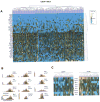Enabling stem cell therapies for tissue repair: current and future challenges
- PMID: 23178704
- PMCID: PMC3620919
- DOI: 10.1016/j.biotechadv.2012.11.006
Enabling stem cell therapies for tissue repair: current and future challenges
Abstract
Stem cells embody the tremendous potential of the human body to develop, grow, and repair throughout life. Understanding the biologic mechanisms that underlie stem cell-mediated tissue regeneration is key to harnessing this potential. Recent advances in molecular biology, genetic engineering, and material science have broadened our understanding of stem cells and helped bring them closer to widespread clinical application. Specifically, innovative approaches to optimize how stem cells are identified, isolated, grown, and utilized will help translate these advances into effective clinical therapies. Although there is growing interest in stem cells worldwide, this enthusiasm must be tempered by the fact that these treatments remain for the most part clinically unproven. Future challenges include refining the therapeutic manipulation of stem cells, validating these technologies in randomized clinical trials, and regulating the global expansion of regenerative stem cell therapies.
Copyright © 2012 Elsevier Inc. All rights reserved.
Figures





Similar articles
-
Clinically relevant aspects of stem cell technologies: current state of play.ANZ J Surg. 2015 Sep;85(9):615-9. doi: 10.1111/ans.12864. Epub 2014 Sep 29. ANZ J Surg. 2015. PMID: 25267417 Review.
-
Enhancing stem cell survival in vivo for tissue repair.Biotechnol Adv. 2013 Sep-Oct;31(5):736-43. doi: 10.1016/j.biotechadv.2012.11.003. Epub 2012 Nov 12. Biotechnol Adv. 2013. PMID: 23153460 Review.
-
Advances in stem cell-based regenerative medicine: Despite setbacks and failures, therapies to replace damaged tissue are making their way into the clinic.EMBO Rep. 2019 May;20(5):e48172. doi: 10.15252/embr.201948172. Epub 2019 Apr 8. EMBO Rep. 2019. PMID: 30962206 Free PMC article.
-
Improving Stem Cell Therapeutics with Mechanobiology.Cell Stem Cell. 2016 Jan 7;18(1):16-9. doi: 10.1016/j.stem.2015.12.007. Cell Stem Cell. 2016. PMID: 26748752 Free PMC article.
-
Nano-regenerative medicine towards clinical outcome of stem cell and tissue engineering in humans.J Cell Mol Med. 2012 Sep;16(9):1991-2000. doi: 10.1111/j.1582-4934.2012.01534.x. J Cell Mol Med. 2012. PMID: 22260258 Free PMC article. Review.
Cited by
-
Skin immunity in wound healing and cancer.Front Immunol. 2023 Jun 16;14:1060258. doi: 10.3389/fimmu.2023.1060258. eCollection 2023. Front Immunol. 2023. PMID: 37398649 Free PMC article. Review.
-
Ultrasound-Assisted Liposuction Does Not Compromise the Regenerative Potential of Adipose-Derived Stem Cells.Stem Cells Transl Med. 2016 Feb;5(2):248-57. doi: 10.5966/sctm.2015-0064. Epub 2015 Dec 23. Stem Cells Transl Med. 2016. PMID: 26702129 Free PMC article.
-
Assessment of three techniques for delivering stem cells to the heart using PET and MR imaging.EJNMMI Res. 2013 Oct 28;3(1):72. doi: 10.1186/2191-219X-3-72. EJNMMI Res. 2013. PMID: 24165377 Free PMC article.
-
Pooled evidence from preclinical and clinical studies for stem cell-based therapy in ARDS and COVID-19.Mol Cell Biochem. 2023 Jul;478(7):1487-1518. doi: 10.1007/s11010-022-04601-2. Epub 2022 Nov 17. Mol Cell Biochem. 2023. PMID: 36394787 Free PMC article. Review.
-
The Mechanism of Pyroptosis and Its Application Prospect in Diabetic Wound Healing.J Inflamm Res. 2024 Mar 6;17:1481-1501. doi: 10.2147/JIR.S448693. eCollection 2024. J Inflamm Res. 2024. PMID: 38463193 Free PMC article. Review.
References
-
- Guidelines for the Clinical Treatment of Stem Cells. International Society for Stem Cell Research Task Force. 2008
-
- Arien-Zakay H, Lecht S, Perets A, Roszell B, Lelkes PI, Lazarovici P. Quantitative assessment of neuronal differentiation in three-dimensional collagen gels using enhanced green fluorescence protein expressing PC12 pheochromocytoma cells. J Mol Neurosci. 2009;37:225–37. - PubMed
-
- Atiyeh BS, Costagliola M. Cultured epithelial autograft (CEA) in burn treatment: three decades later. Burns. 2007;33:405–13. - PubMed
-
- Baker M. Stem-cell pioneer bows out. Nature. 2011;479:459. - PubMed
Publication types
MeSH terms
Grants and funding
LinkOut - more resources
Full Text Sources
Other Literature Sources

